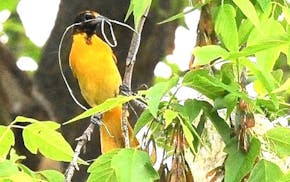Q: When do orioles migrate back to our area?
A: Baltimore orioles, favorite spring migrants for many of us, usually begin to return in late April in the metro area, with most settling in by mid-May. My bird journals show that I tend to hear my first oriole around May 4 each year. You can hear the sweet whistle-y songs of these gorgeous orange birds here: allaboutbirds.org/guide/Baltimore_Oriole/. Checking the All About Birds website maintained by the Cornell Lab of Ornithology, I learned that the oldest Baltimore oriole on record was 12 years old when it was caught by a raptor in Minnesota.
Oriole invitation
Q: How can I attract orioles to nest in my backyard?
A: Baltimore orioles live on a diet of nectar, fruit and insects, so to approximate their natural diet, you could offer orange halves and grape jelly in springtime. However, oriole pairs prefer to establish their nests near water, either a lake, river or pond. If you don't live close to a water source, chances are that you won't have orioles nesting nearby.
Merlin hears merlin
Q: My husband and I were out in our yard when we heard a bird call that we didn't recognize. Using the Merlin Bird ID app, we learned that it was a merlin. We watched it for a long time as it sat on a treetop and heard another merlin answer its calls. How often are merlins seen in the city and will they stalk our bird feeders?
A: What a fun coincidence, that you heard an unknown bird and the Cornell Lab of Ornithology's bird identification app named Merlin identified it as a merlin. These members of the falcon family do prey on small birds so if they remain in your area, they will probably eat some of your feeder birds — they're known to prey on house sparrows, for example. These small hawks are increasingly nesting in towns and cities, but they're still an unusual sight in the metro area. (The Merlin app is free and downloadable from the App Store or Google Play. The app can suggest an ID based on a photo you take, or sounds a bird makes.)
Making it easy for hawks?
Q: There's a Cooper's hawk in the neighborhood and he seems to be haunting our backyard. I'm wondering if our feeders are making it too easy for him or her to catch our birds. One day I looked out and the hawk was eating a male cardinal for lunch. Then later that same day it was eating a chickadee.
A: That's a good question, and I'm sorry to hear that the hawk, which eats smaller birds, is feasting on exactly the birds you want to attract to your feeders. Researchers have looked into this and report that fewer birds are caught at feeders than out in natural settings: Birds tend to bunch up at feeders, and this means more eyes keeping watch and sounding an alarm if a predator is spotted.
Out of view
Q: What's up with the DNR's camera on the eagle's nest? I can't seem to see any eagles.
A: The DNR's EagleCam is no longer providing a view of eagle parents at their St. Paul nest, possibly due to high winds having shifted the camera. Since the eagle pair are actively incubating their eggs, the DNR doesn't want to cause any disturbance so it won't be adjusting the camera this season, although you may occasionally see views of an eagle coming or going. An alternative: The DNR FalconCam season is underway, providing views of a peregrine falcon pair at their nest box in downtown St. Paul (mndnr.gov/falconcam).
Feeders fueling migrants?
Q: What migratory birds can I expect at my feeders?
A: That's an interesting question, and the answer isn't completely straightforward. Nearly all birds that leave on migration in the fall do so not because cold weather is coming, but because their food is disappearing. Most migrants live on fruit or insects, and these dwindle as the weather gets colder. It's our non-migratory birds, like woodpeckers, chickadees and finches — birds that consume seeds and nuts — that can be found at feeders year-round. However, some migratory birds can be drawn in by suet, which approximates the protein delivered by insects, or by live insects (think mealworms and bluebirds). And some will come in for nectar, including hummingbirds and orioles. It's a little chance-y, but if you provide the diet they prefer, some migratory birds will show up at your feeders.
Rare pheasant
Q: I've seen an unusual-looking pheasant on the shores of Lake Nokomis several times and an online search revealed that it's a green pheasant, a bird from Asia. What is it doing here?
A: There have been a number of reports of this bird this winter and you're right, it's more at home in Japan. I checked with the Minnesota Ornithologists' Union and president Justin Watts noted that the bird has been around since last November. It's often assumed that unusual birds like this one are escapees from game farms, but Watts points out that there are no game farms anywhere near this site and it would be rare for such a bird to be raised for game purposes. So it looks as if the green pheasant's origins will remain a mystery.
Shadowy birds
Q: On a sunny March day I noticed some small birds perched 10 feet up in the shadows on a pine tree. First one and then more gathered in the pine's shadow. The only thing I can figure is that they were using the tree's shadow as cover from predators. Any thoughts? I have seen wolves cross a highway in the shadow of trees. Same idea?
A: I like your theory, but thought I'd run it by Laura Erickson, renowned birder, author and radio host based in Duluth. She notes that if it was a windy day, the birds might have been seeking protection from the wind. If you see such a gathering again, check whether the birds are on the leeward side of the tree. I have no idea what the wolves were doing.
Hummingbirds and water
Q: Do hummingbirds need water?
A: Good question, and while the nectar they drink provides the hydration they need, hummingbirds do need to bathe to keep their feathers in tip-top shape. So they appreciate having a birdbath to surf across or a water fountain to zip through.
St. Paul resident Val Cunningham, who volunteers with bird organizations and writes about nature for local, regional and national newspapers and magazines, can be reached at valwrites@comcast.net.

Minnesota plant sales offer bargains and gardening tips — here are 38 to check out

3 St. Paul restaurants and a Minneapolis food hall are closing

Author of book on Acme Comedy Co. lists his favorite local comics

